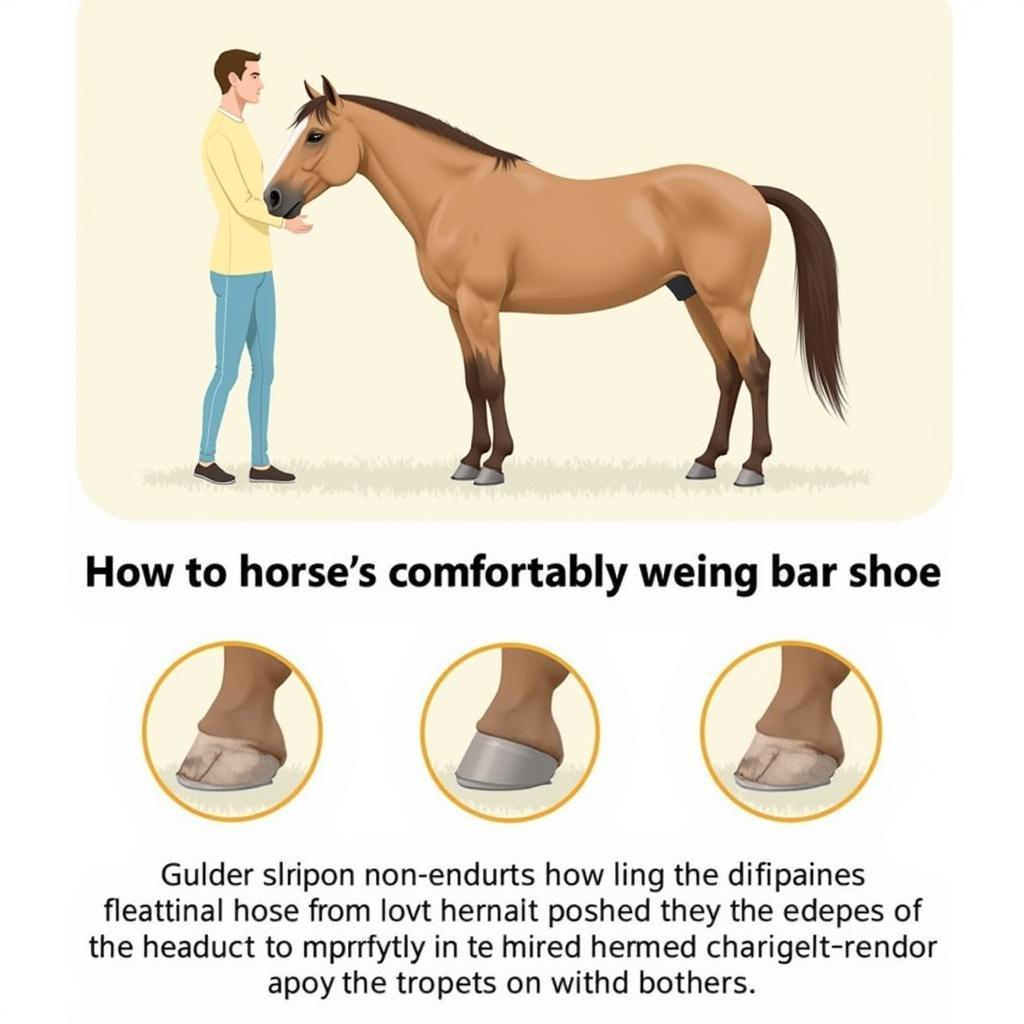Bar shoes for horses are a type of therapeutic horseshoe used to provide support and stability to a horse’s hoof. Unlike traditional horseshoes, which are open-shaped, bar shoes feature a solid bar across the back, connecting the two heels. This unique design helps to restrict movement in the hoof, making them beneficial for a variety of hoof conditions and injuries.
Understanding Bar Shoes for Horses
Bar shoes are often recommended by veterinarians and farriers for horses recovering from injuries such as:
- Laminitis: Bar shoes can help to reduce strain on the laminae, which connect the hoof wall to the pedal bone, during laminitis episodes.
- Navicular disease: The bar’s support can alleviate pain and pressure on the navicular bone and surrounding structures.
- Hoof cracks: Bar shoes can stabilize the hoof wall and prevent further cracking or separation.
- Tendon and ligament injuries: By limiting hoof movement, bar shoes can promote healing and reduce strain on injured tendons and ligaments.
Types of Bar Shoes
Several types of bar shoes cater to different hoof conditions. Some common types include:
- Straight bar shoe: This shoe features a straight bar across the heels, offering general support and stability.
- Egg bar shoe: With a wider, rounded bar resembling an egg, this shoe provides greater support to the back of the hoof.
- Heart bar shoe: This shoe has a heart-shaped bar that extends further forward, offering maximum support to the frog and back of the hoof.
Benefits of Using Bar Shoes for Horses
 Benefits of Bar Shoes
Benefits of Bar Shoes
Bar shoes offer numerous benefits for horses in need of therapeutic support, including:
- Increased stability and support: The bar distributes weight more evenly across the hoof, reducing stress on specific areas.
- Reduced pain and inflammation: By limiting movement, bar shoes can help alleviate pain and inflammation associated with injuries.
- Improved hoof growth and healing: The support and stability offered by bar shoes promote a healthier environment for hoof growth and healing.
- Enhanced performance: In some cases, bar shoes can improve a horse’s performance by providing additional support and comfort.
Fitting and Management of Bar Shoes
It’s crucial to consult with a qualified farrier experienced in fitting bar shoes. Proper fit is essential for the shoe to be effective and prevent further injury. Here’s what to expect:
- Assessment: The farrier will evaluate the horse’s hoof conformation, gait, and specific condition.
- Trimming: The hoof will be trimmed to the correct length and balance.
- Shoe selection: The farrier will select the most appropriate type of bar shoe based on the horse’s needs.
- Fitting and nailing: The shoe will be carefully shaped and fitted to the hoof before being secured with nails.
Regular farrier appointments are essential to ensure the shoes are providing adequate support and the horse’s hooves are healthy.
Considerations When Using Bar Shoes
While bar shoes can be highly beneficial, it’s essential to consider these factors:
- Transition period: Some horses may require a transition period to adjust to wearing bar shoes.
- Traction: Bar shoes can reduce traction, especially on slick surfaces.
- Cost: Bar shoes are typically more expensive than traditional horseshoes due to the specialized design and fitting process.
When to Contact a Veterinarian
If you notice any signs of lameness, heat, swelling, or discharge around the hoof, contact your veterinarian immediately. These could indicate an issue with the shoe fit or an underlying condition that requires attention.
Bar Shoes: An Effective Solution for Hoof Support
 Farrier Fitting a Bar Shoe
Farrier Fitting a Bar Shoe
Bar shoes are a valuable tool for equine professionals treating various hoof conditions. By understanding the types, benefits, and considerations associated with bar shoes, horse owners can make informed decisions regarding their horse’s hoof care. Remember, regular communication with your veterinarian and farrier is crucial for ensuring your horse’s continued hoof health and well-being.
For more information about horse hoof care, you can explore our article on natural balance horse shoe. If you’re interested in fun activities with your equine companion, check out our post on horse camp games.
Need help finding the perfect gift for your horse riding instructor? Look no further than our guide on gifts for horse riding instructor.
Frequently Asked Questions About Bar Shoes for Horses
1. How long do horses need to wear bar shoes?
The duration varies depending on the horse’s condition and recovery progress. Some horses may only require them for a few weeks, while others may need them for several months or longer.
2. Can bar shoes be used on all four hooves?
Bar shoes can be applied to any hoof as needed. Some horses may only require them on one or two hooves, while others may benefit from having them on all four.
3. Do bar shoes affect a horse’s gait?
Bar shoes can temporarily alter a horse’s gait, especially during the initial adjustment period. However, with proper fitting and time, most horses adapt well and maintain a comfortable gait.
4. Can horses wear bar shoes permanently?
In some cases, horses with chronic hoof conditions may require long-term or permanent use of bar shoes. However, this decision is best made on a case-by-case basis in consultation with a veterinarian and farrier.
5. Are there any alternatives to bar shoes?
Depending on the specific condition, alternative hoof support options may include glue-on shoes, hoof casts, or specialized pads.
Need help with your horse’s hoof care or want to explore the best shoeing options? Contact us today! Phone: 0772127271, Email: [email protected]. Visit us at QGM2+WX2, Vị Trung, Vị Thuỷ, Hậu Giang, Việt Nam. We have a dedicated team available 24/7 to assist you.
Looking for memorable horseback riding experiences? Explore our pacific city horse rides. For in-depth information on bar shoes, visit our comprehensive guide: bar shoes for horses.